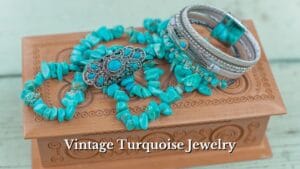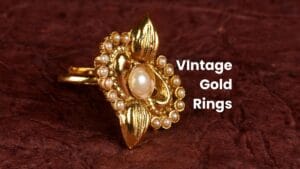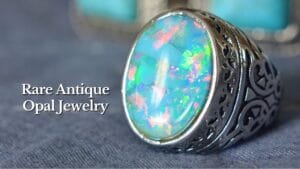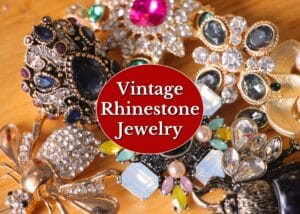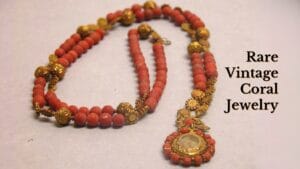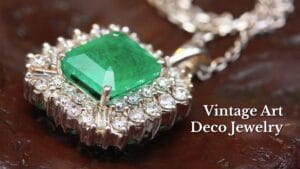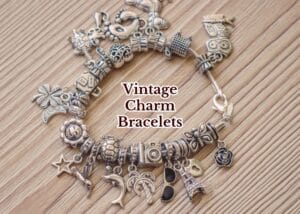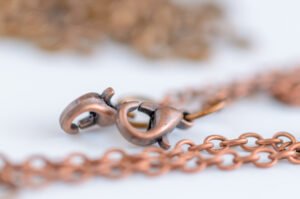Do you have an old jewelry piece with a vibrant blue stone featuring veining patterns? If yes, there is a solid chance you’re holding rare vintage turquoise jewelry worth $5,000 or even more!
But here’s the thing about turquoise jewelry – stabilized stones are marketed as natural, howlite is passed off as genuine turquoise, and “vintage” pieces were made last week in China.
So, is there a way to know whether a turquoise piece is real? Scroll down to learn how to authenticate real vintage turquoise, understand the factors that create five-figure values, and discover some rare pieces collectors are hunting for.
What Is Turquoise & Why Is It So Collectible?
Turquoise was among the first gems humans ever mined and traded – we’re talking 5,000+ years. Ancient Egyptians were crafting turquoise jewelry before most civilizations discovered metalworking.
The stone’s name comes from the French “pierre turquoise” (Turkish stone) – the Silk Road trade routes, where Europeans first encountered it. It forms under very specific conditions: copper-rich groundwater seeping through aluminum-bearing rock in a specific climate.
Unlike diamonds, turquoise develops near the surface through a slow process. Water carries dissolved minerals through rock cracks over thousands of years, and those distinctive “matrix” patterns are the original host rock showing through.
Such a complicated and long formation process is exactly why finding natural, antique turquoise is extremely rare, making it super valuable!
Key Signs to Spot Real Vs. Fake Turquoise Stone!
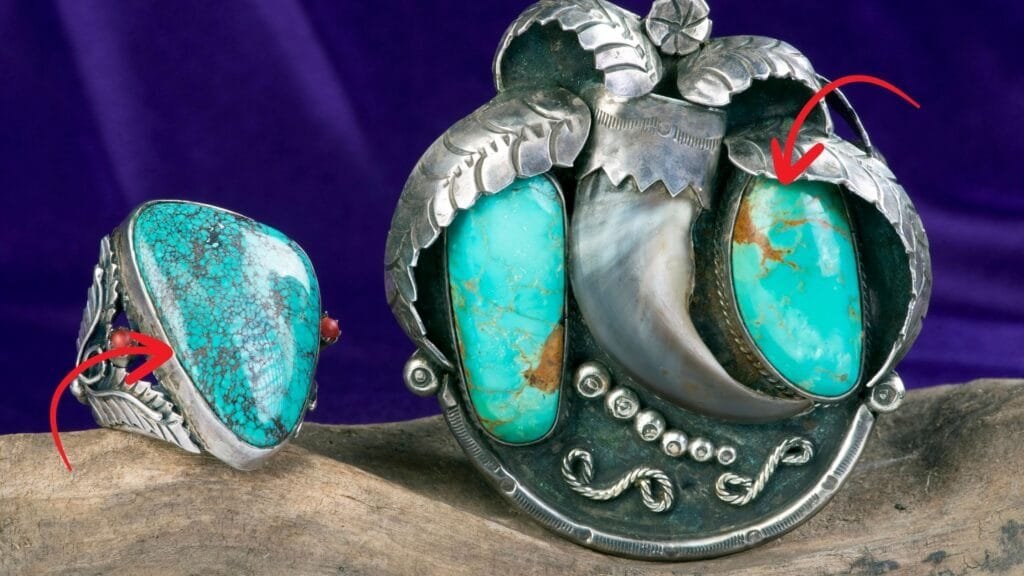
Just like many other gemstones, there are many imitations and treated turquoise stones in the market. And, spotting a genuine stone from fakes takes a good eye and some know-how.
Here are the key features and signs that will help you determine what you’re looking at:
Types of Turquoise
Authentic turquoise comes from mines worldwide, each with its own characteristic color and matrix patterns. Some of the most coveted vintage turquoise comes from American mines that are now tapped out, making them even rarer and more valuable.
- Sleeping Beauty Turquoise: One of the most desirable turquoises, this one is from Arizona and it’s valued for its pure, solid sky blue color with little to no matrix. Although softer, it’s a favorite of Native American jewelry. But since the mine is closed, it’s rare!
- Red Mountain Turquoise: Mined in Northern Nevada, this stone displays reddish or golden tones because of its intricate dark spider webbing. The mine is mostly exhausted, making these stones rare and highly collectible.
- Kingman Turquoise: One of the most famous American turquoises, Kingman is known for its brilliant blue color and varied dark blue matrix patterns. Miners in Arizona first mined this stone 600 B.C.E., making it supersignificant!
- Number 8 Turquoise: This came from a Nevada mine that’s now depleted. It’s distinctive and highly prized for its golden-brown to black spiderweb matrix.
- Lander Blue Turquoise: Hailed as one of the world’s rarest and most valuable turquoise, this stone from Nevada features a deep blue color with a tight, black spiderweb matrix. Only a total of around 110 pounds of this stone were ever extracted.
- Morenci Turquoise: The heavy iron pyrite or “fool’s gold” matrix of this Arizona stone gives it a beautiful, sparkling look – something collectors know it for!
- Carico Lake Turquoise: From Nevada, this turquoise ranges from sky blue to striking lime green because of its high zinc content. The rarest pieces feature both colors with a spider web matrix. The small annual yield makes the high-grade green stones, which constitute less than 3%, exceptionally rare.
Color Authentication
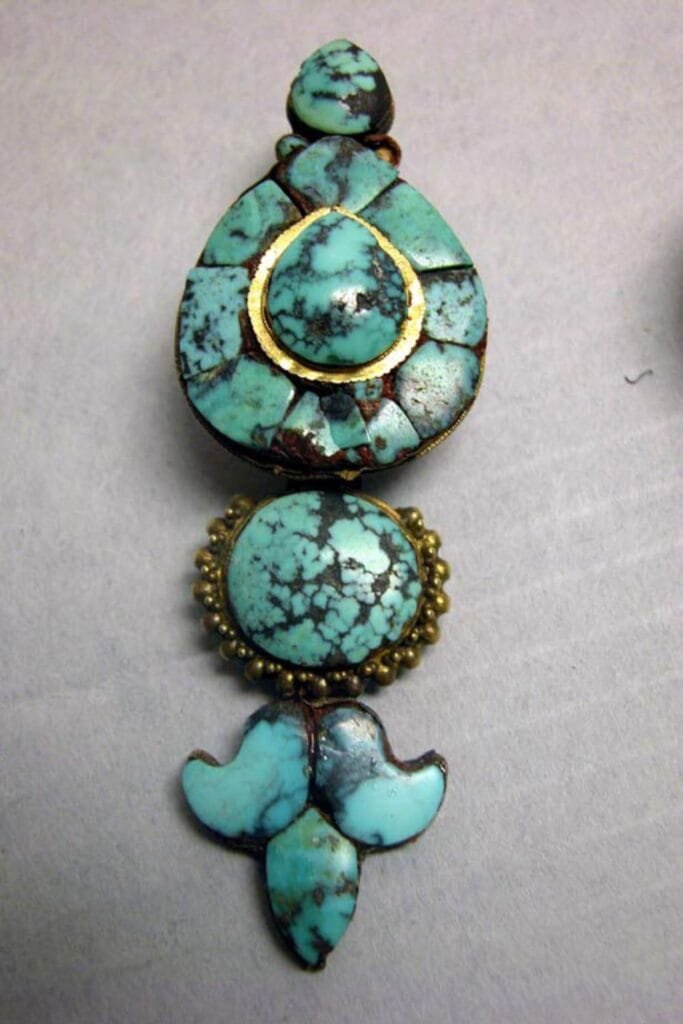
The first key feature of a real turquoise stone is its distinctive color! Real turquoise is hardly uniformly bright blue – it usually has more of a greenish blue or pale blue toning. An extra bright or vibrant turquoise may be a reproduction or fake.
Second, a real turquoise will have color variations throughout the stone due to varied exposure. A dyed howlite stone will have the same color throughout the stone, with minimal to no gradient or toning.
Also, remember that natural turquoise changes color, often deepening and becoming more greenish as it absorbs oils from skin. This natural aging process, or patina, is very desirable in antique pieces.
Texture & Patterns
Those veins and host rock within the turquoise, technically known as the matrix, are a key characteristic of a real stone. In genuine turquoise, the matrix is part of the stone itself. You can often feel the texture of the matrix with your fingernail.
Fake turquoise often has a painted-on or injected matrix that sits on the surface and feels smooth.
Another sign is that the natural cracks in antique turquoise are often filled with dirt and debris that’s built up over time. Reproductions or fakes don’t have these cracks, either.
Easy Authentication Tests
There are a few simple tests that you can easily do to check whether or not your Turquoise is real:
- The Scratch Test (Least Risky): Use this on an inconspicuous spot. Real turquoise should resist light scratching but show marks from moderate pressure. Howlite or other fake turquoises scratch much more easily.
- The Heat Test: Touch a heated pin onto the stone. Natural turquoise has no smell or a faint mineral scent on doing so, whereas stabilized turquoise might have a slight resin odor. If it’s plastic, you’ll smell it! (Only do this on pieces you own, and only if you’re prepared for potential damage.)
- The Acetone Test: Soak a part of the stone overnight in acetone. Dyed materials may leach color. Again, only use this on pieces you own.
If you’re afraid of ruining a real turquoise, it’s best to get professional gemological testing, especially for valuable pieces. Labs can identify treatments, confirm authenticity, and sometimes even determine mine source.
What Makes Old Turquoise Jewelry Valuable?
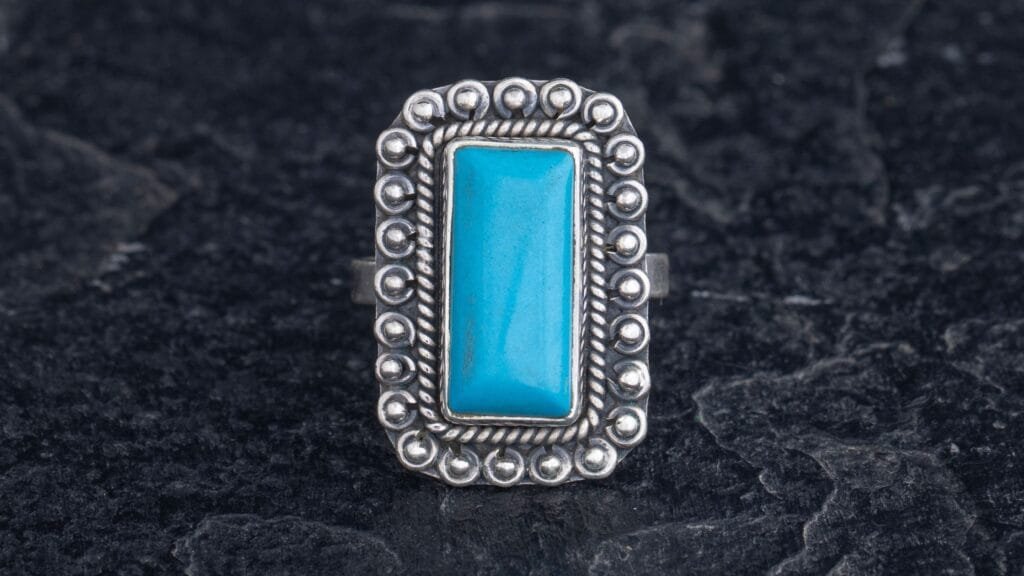
Now that you can identify real turquoise, let’s understand what makes certain turquoise pieces worth $5,000+, and some just $50. Here’s a detailed breakdown of key value factors:
Turquoise Quality
The first and most important factor is, of course, the turquoise’s quality. Here are the key things that matter:
Natural vs. Treated
This difference makes a vast difference. Natural, gem-quality turquoise that hasn’t been treated or enhanced is the most valuable of all.
Mine Source
With turquoise, the mine where the stone came from matters more than color, size, or even beauty. It’s all about rarity and reputation.
Here are some top-tier American mines that can spike the value of a piece:
- Lander Blue (Nevada): This mine produced maybe 100 pounds total before closing. A single carat can sell for $400-600. The spider web matrix is so distinctive that experts can spot it across a room.
- Sleeping Beauty (Arizona): Produced the most consistently pure blue turquoise ever found. The mine closed over a decade ago, making existing pieces increasingly valuable.
- Bisbee (Arizona): This mine gave the deep blue stone with a chocolate-colored matrix. The copper mine that produced it is long closed, making high-grade Bisbee worth $500+ per carat.
- This mine’s black spider web matrix on blue-green backgrounds is quite famous among collectors. Now closed, natural turquoise from Number 8 mine is highly collectible.
- Kingman (Arizona): This is one of the oldest mines in America that still produces turquoise. The quality varies widely, but top-grade Kingman with spider web matrix commands strong prices.
- Royston (Nevada): This mine is known for its beautiful blue-green stones with brown matrix. It’s still active but yields only limited production.
Color Grading
The value of an antique turquoise jewelry piece greatly depends on its color’s vibrancy, veining, and depth. How? Deep colors and complicated, dramatic matrices (veining) are worth more than clear stones.
Here’s a quick breakdown of how colors impact the worth:
- Robin’s Egg Blue: This is a premium color. It’s typically a clear, pure blue stone with no green tinting.
- Persian Blue: It’s a clear sky blue stone with minimal to no matrix. Historically, it’s the most prized turquoise color.
- Spiderweb Blue: Deep blue stones with attractive matrix patterns can be more valuable than solid blue, especially for exceptional webbing.
- Green Variants: Generally, green turquoises are less valuable, but some varieties, like those from mines like Carico Lake, are specifically prized.
Hardness and Stability
The hardest, most stable turquoise requires little to no treatment, making it significantly valuable. But how to spot a hard turquoise? Here are its key features:
- Natural hardness of 5-6 Mohs
- Low porosity (denser stone)
- Resistance to color change
- Ability to take a high polish
If a stone checks all these features off, it can be super valuable!
Overall Condition
Just like all antiques, condition largely impacts the value of a vintage turquoise jewelry piece. Examples in fine or excellent condition are naturally worth more than ones in poor condition.
Generally, natural turquoise pieces in good condition feature:
- Original polish and luster still evident
- Stones secure in their settings
- Natural patina due to age
- Matrix integrity maintained
- Minimal chips or significant scratches
If a piece has all these signs, you’re holding a well-preserved turquoise piece that can be worth a big fortune.
On the other hand, the following signs are a big red flag:
- Artificial aging attempts
- Loose stones that rattle in settings
- Modern-looking repairs or replacements
- Warped or worn-out metalwork
- Significant structural damage
Setting Materials & Other Stones
The type and quality of accompanying materials affect turquoise jewelry’s value as much as the stone itself. For example, a turquoise ring set in 18K gold will fetch way more than one set in Sterling.
So, here’s how the setting material and the presence of other valuable stones influence the value:
Silver Quality and Age
Antique turquoise pieces made with coin silver, which has a 90% silver content (Pre-1900), are often hand-forged and extremely valuable. Sterling silver pieces from post-1900 with 92.5% silver content also fetch decent prices.
Also, original hand-finished sand-cast metalwork commands higher prices than mass-produced pieces. Similarly, turquoise pieces with hand-tooled stamp designs show more irregularity and character than machine work, fetching higher values.
Gold Combinations
Turquoise set in high-karat gold settings is super valuable, with even single tiny pieces reaching $1,000. Generally, gold bezels and accents increase the value of a turquoise piece, especially when it’s
- 14k or higher gold content
- Hand-fabricated rather than cast
- Period-appropriate techniques
- Signed by recognized artists
Gemstone Combinations
When turquoise pairs with other invaluable gemstones, such as diamonds, rubies, corals, opals, emeralds, and jadeites, it can double its value! But the overall value also depends on the condition of the stones and metal.
9 Rare Turquoise Jewelry Pieces Worth Money
Now that you can easily spot rare vintage turquoise jewelry, here are some valuable pieces you need to find in your jewelry box right away!
1. Rare Sleeping Beauty Turquoise & Halo Diamond White Gold Ring
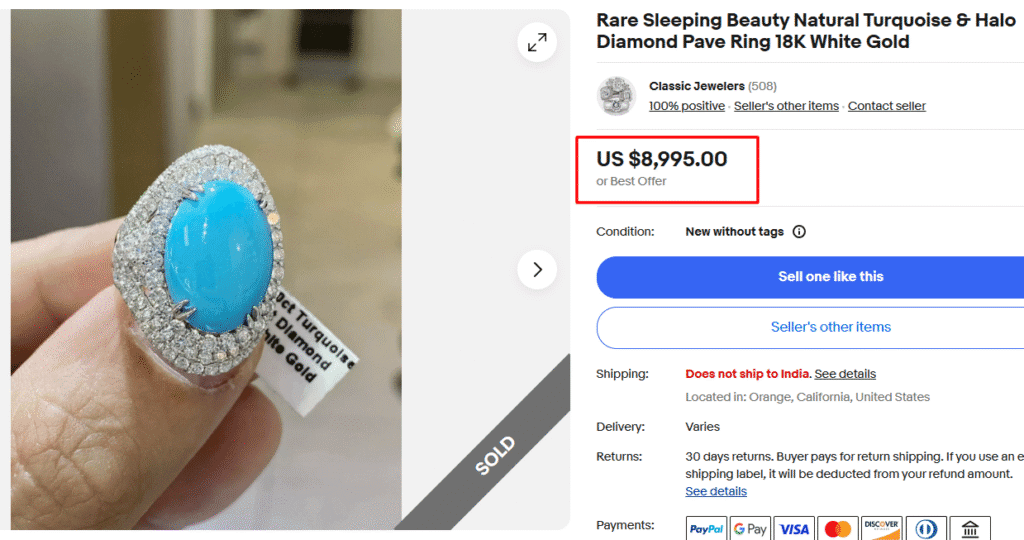
The most expensive item on our list is a luxury ring with a genuine Sleeping Beauty turquoise! As I’d told you above, this is the most sought-after American turquoise known for its pure robin’s-egg blue color with no matrix.
Besides, the 18K white gold setting features a full halo of diamonds surrounding the central turquoise cabochon, creating a super valuable combination – hence the price tag of over $8,990!
This is an example that such mint-condition turquoise jewelry pieces with original tags and labels can command high premiums.
2. “Leaf Suite” Sterling Silver Turquoise Necklace & Ring
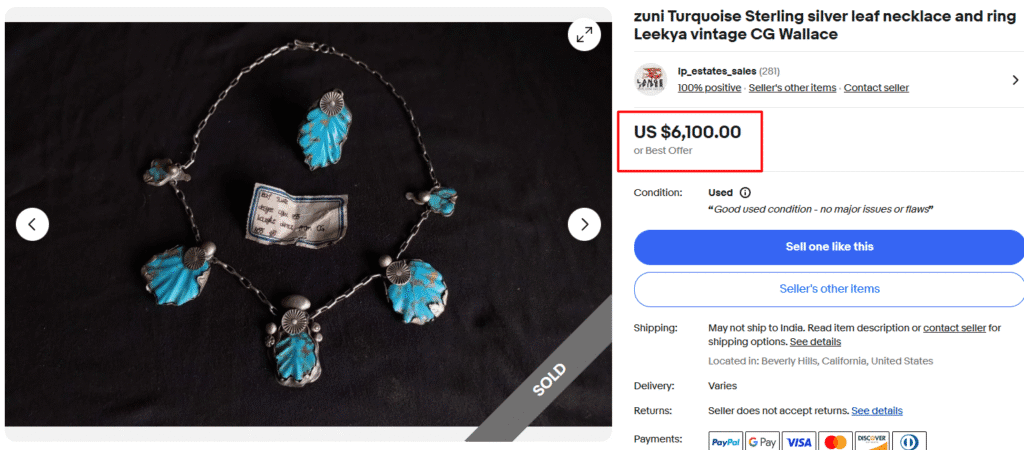
This matching turquoise jewelry set is a true example of vintage Zuni craftsmanship! The stunning leaf design reflects the intricate channel inlay work, where each turquoise piece is perfectly fitted into individual silver channels.
The matching ring completes the set, which is extremely rare to find intact. This is a CG Wallace piece, which you can authenticate by the superior quality turquoise! Finding complete sets with intact stones is quite rare; that’s why this set sold for over $6,000!
3. Vintage Navajo/Zuni Sterling & Turquoise Belt
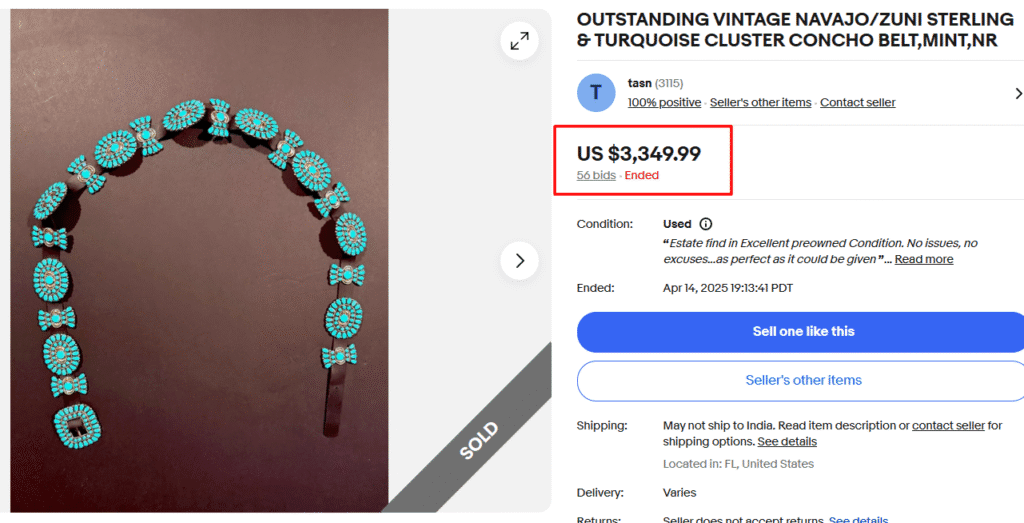
This concho belt sold for a whopping $3,350! Why? The belt features the exemplary cluster technique, in which multiple turquoise stones are arranged in floral patterns. What makes this belt special is the blend of Navajo silversmithing with Zuni stone-setting expertise.
Each belt shows hand-stamped borders and perfectly matched turquoise. Also, the stones are natural, untreated, with that classic robin’s-egg blue coloration that adds to the value. You can verify quality by checking for uniform stone color and tight bezels throughout the concho.
4. Hopi Victor Coochwytewa Native Bear Turquoise Ring
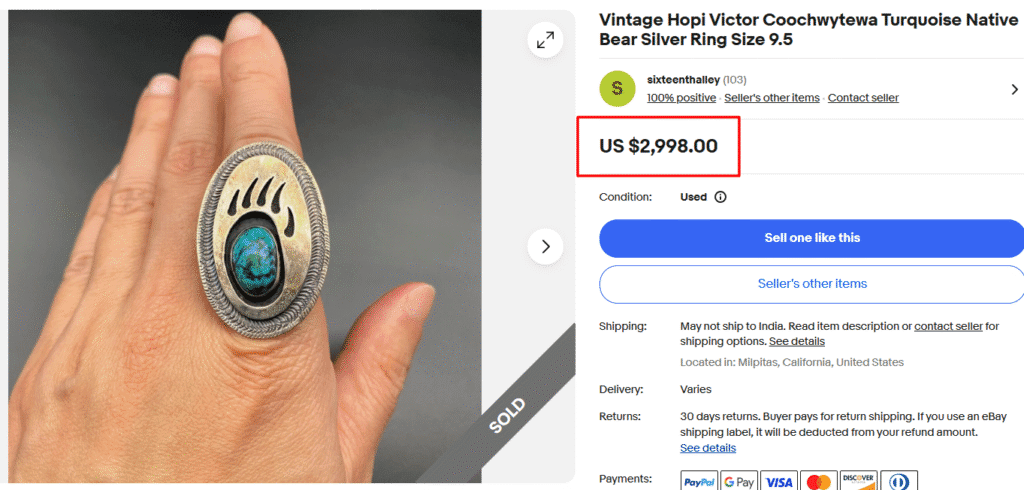
This antique ring shows Coochwytewa’s iconic textured overlay technique that became the standard for modern Hopi jewelry. The bear paw design is cut from the silver frame, making the smooth overlay pattern pop dramatically.
And the turquoise stone appears to be high-grade material with a dramatic matrix, perfectly centered in the oval setting. And the thick, substantial silver band makes this ring a museum piece! You can identify such Coochwytewa work by this distinctive matted texture.
5. Charles Loloma Sterling & Turquoise Jet Hopi Earrings
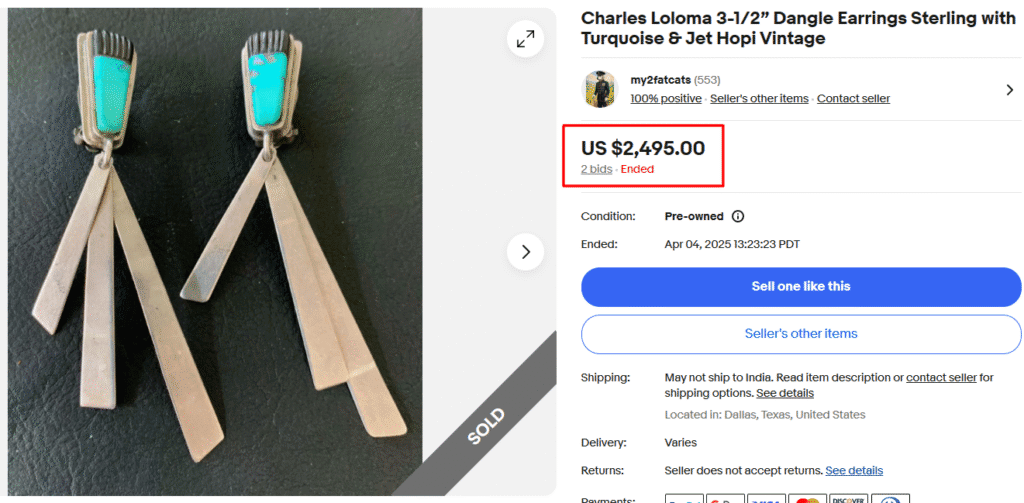
These vintage turquoise earrings show off the iconic combination of turquoise and jet, typical of Charles Loloma. Born in 1921 on Hopi’s Third Mesa, Loloma literally changed the game for Native American jewelry.
While other artists stuck to traditional silver and turquoise, Loloma threw in gold, lapis lazuli, and even diamonds. The unique geometrical shapes on these earrings also give it an Art Deco feel, making them valuable!
6. Eddie Beyuka Zuni Turquoise & Coral Silver Bracelet
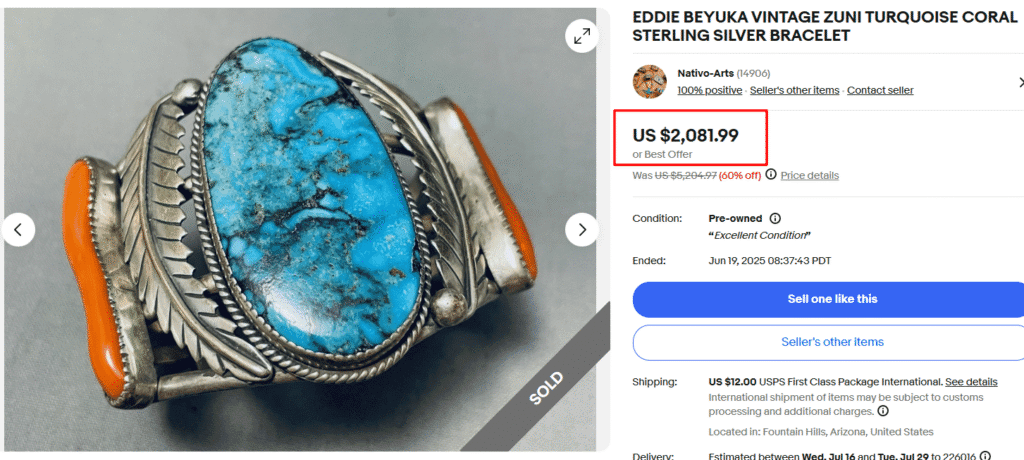
This antique turquoise bracelet is a masterpiece by Eddie Beyuka, one of Zuni’s most celebrated artists from 1920 to 2002. What makes this piece special? Beyuka was famous for his intricate channel inlay work, and this bracelet showcases it perfectly.
You can spot this piece by its large turquoise stone and accompanying corals, all set in an ornate Sterling silver frame with excellent carving. Turquoise and natural coral make a high-end and rare combination that’s highly desirable – no wonder this piece sold for over $2,000.
7. Navajo Green Turquoise Sterling Bracelet
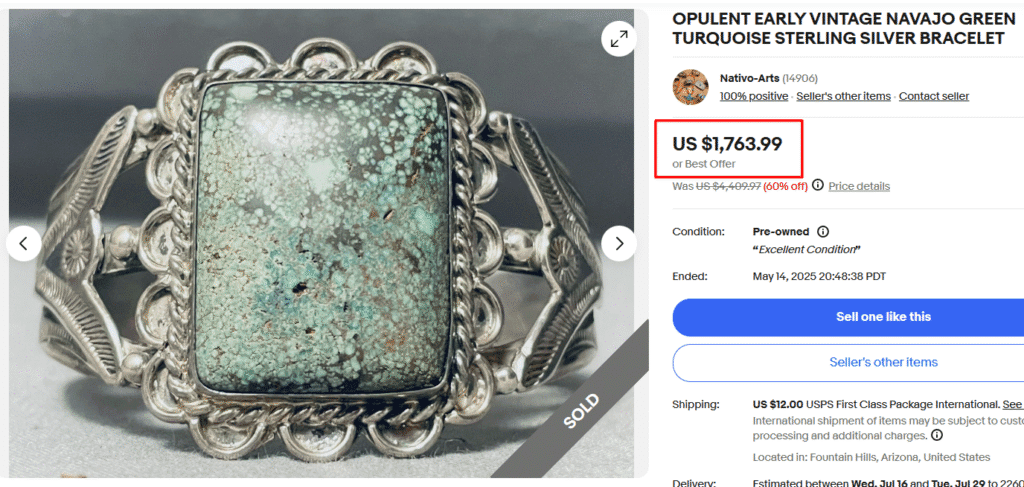
This is a museum-quality cuff decorated with a rare green turquoise, likely from Nevada mines like Royston or Carico Lake that produce distinctive green-blue stones. The massive rectangular center stone features natural matrix patterns in brown and black spider web.
This piece is a true example of early Navajo jewelry thanks to its heavy-gauge silver frame with hand-stamped decorative elements and substantial weight. The green turquoise is rare since most collectors focus on blue ones, making them increasingly valuable.
8. Cartier Turquoise Yellow Gold Crab Brooch Pendant
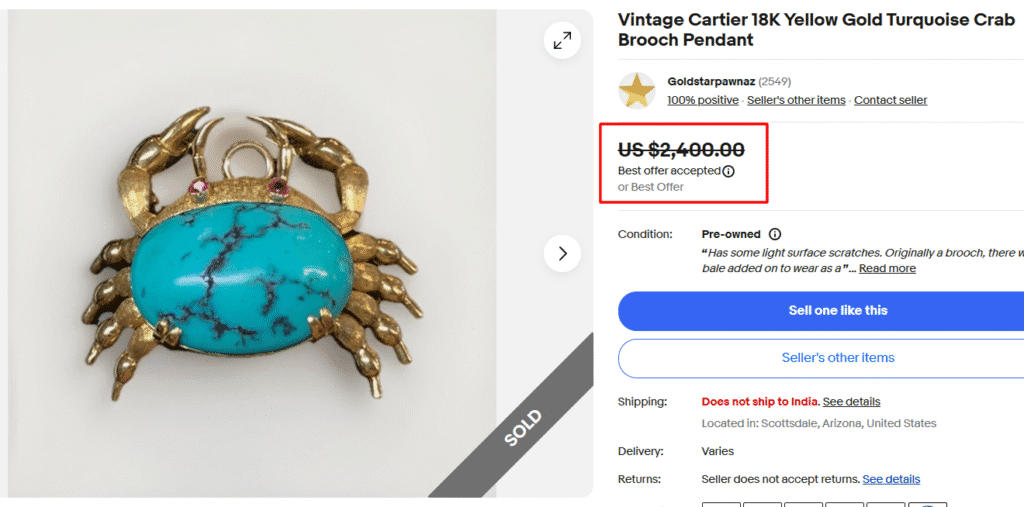
This exceptional crab-shaped brooch is from Cartier, the animal-shaped jewelry the fashion house is known for! The crab features a large turquoise cabochon as its shell with ruby-set eyes and gold claws and body.
You can spot authentic Cartier pieces from this era by the carved markings, like “Cartier,” along with numbers. The high-grade quality of the turquoise and 18K gold work makes this small brooch pin worth the steep price of $2,000+!
Cartier’s animal brooches from the 1940s-60s are highly collectible today, especially with such precious gemstones.
9. Navajo Number 8 Turquoise & Sterling Lariat Necklace
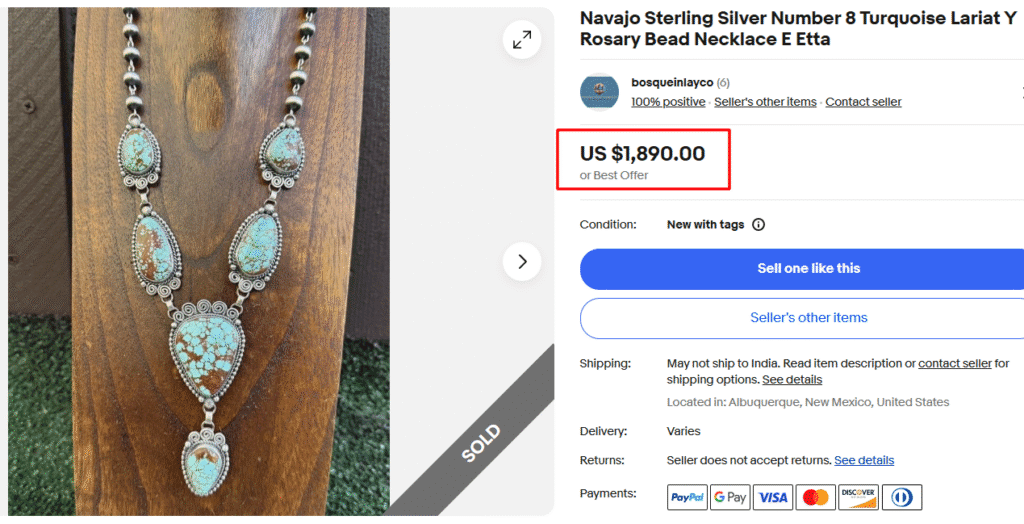
This dramatic lariat-style necklace features the highly prized Number 8 turquoise set in an ornate Sterling silver beaded frame! You can spot this stone by its distinctive blue-green color with characteristic black or golden spider webbing matrix.
The necklace has a Y-shaped design, with graduated teardrop-shaped stones that get larger toward the center pendant. This single piece sold for almost $1,900 because the Number 8 turquoise is incredibly valuable, and it has 6 such rare stones!
Note: This article is intended for informational, educational, and entertainment purposes only. Some images are illustrative and may not represent actual brands, products, or related entities. All trademarks, product names, brand logos, packaging, and other intellectual property referenced remain the exclusive property of their respective owners. Any brand mentions or references are provided solely for descriptive and educational context and do not imply any formal or commercial association.

